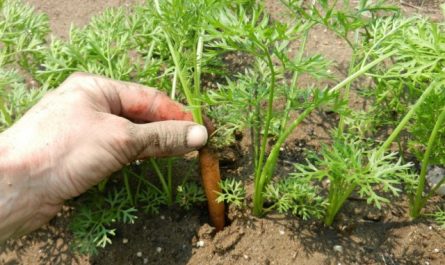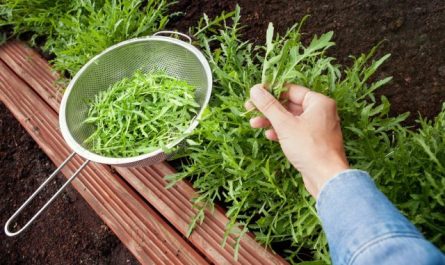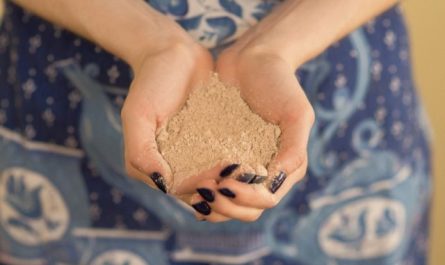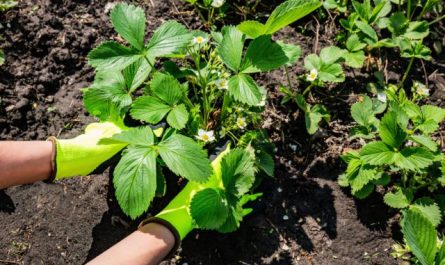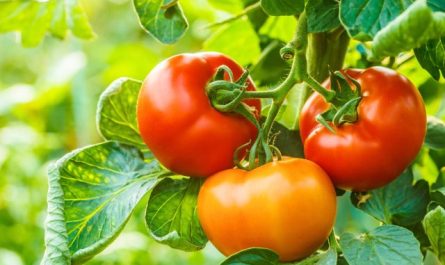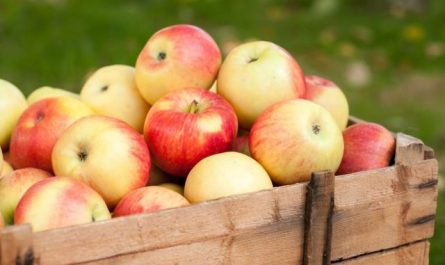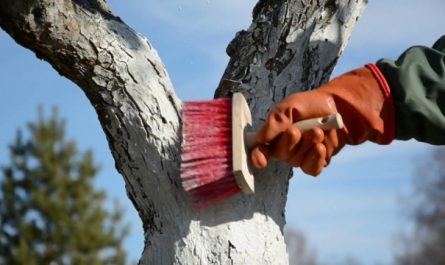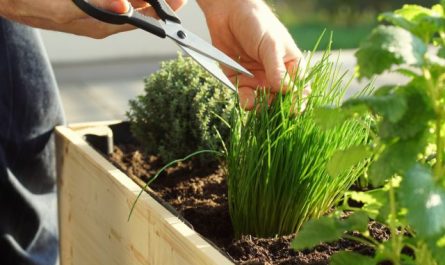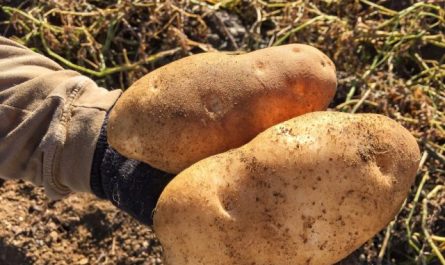There is no clear answer to the question: “When is it better to plant fruit trees – in spring or autumn?”. Many factors need to be taken into account: the climate of the cultivation region, the type of crop, the form of packaging and even the type of soil on the site. Planting a garden is a very important moment. Transplanting an adult plant is problematic, and fruit trees will develop well and bear fruit abundantly only if they take root well. You will learn about the intricacies of choosing seedlings and the best time to plant stone and pome fruits.

Seedlings with open roots and closed roots – what to choose?
The letter abbreviation is used to indicate the method of growing fruit trees and the type of packaging of their root system before sale.
Open root system seedlings (ORS)
Seedlings with open root system are grown in nurseries in open ground. By autumn, when shoots become woody and all vegetative processes slow down, they are dug up and sold with a bare root system. To prevent seedlings from drying out, the roots are wrapped in polyethylene, temporarily dug into peat, wet sawdust, dipped in hydrogel or clay slurry.
Advantages of seedlings with open root system:
- You can choose a plant with a well-developed root system. See how healthy it is, whether there are any rotten roots.
- The price of trees with open root system is lower than that of trees with closed root system.
- Seedlings without a pot of soil are lighter and easier to carry.
- Usually, zoned varieties are sold with an open root system. It is easier to transport plants in pots over long distances.
Disadvantages of seedlings with open root system:
- When digging out of the ground, some of the roots are cut off. The plant has to spend energy on their restoration. In addition, an infection can get inside through the wounds.
- The limited period for selling seedlings is early spring and a month and a half in autumn.
- It is advisable to plant the purchased tree as soon as possible.
- Lower survival rate than seedlings with a closed root system. Inexperienced gardeners cannot distinguish a dormant tree from a dried one when buying.
Important! When in doubt about the quality of a seedling, break off a bud. If it is green inside, the plant is alive; if it is dry, it is better to look for another one. There is a high probability that it is dead.
Seedlings with closed root system (CRS)
Seedlings with a closed root system are grown in greenhouses or nurseries in technological containers. Then they are transplanted into pots filled with special soil, and in this form they go on sale.

Advantages of seedlings with closed root system:
- Plants in closed root systems can be purchased in advance and moved to open ground when there is free time and suitable weather.
- There are no strict restrictions on planting times.
- Potted seedlings are easy to transport over long distances. They only need to be watered on time.
- When transplanting from a pot to a garden, the plant’s roots are almost not damaged, which improves its survival rate.
Disadvantages of seedlings with closed root system:
- It is impossible to see the quality of the root system in a pot.
- The cost of planting material with closed root system is higher than with open root system.
- The weight of a tree with a pot filled with soil is greater than with bare roots.
Author’s opinion (subjective and unpopular)
Despite the fact that seedlings with a closed root system are considered better than with an open root system, I prefer the latter. Fruit trees are large plants that need abundant nutrition from the first days of life. Crops growing in a nursery in open ground are not limited in space, their roots receive all the necessary elements from the soil. A small pot, even if you fill it with fertilizers, cannot fully “feed” the seedling sitting in it, which should subsequently become a giant 3-4 m high.

It may be a coincidence, but all the seedlings with open root system that I planted (and my garden is large) grew into large, fruit-bearing trees. But several seedlings with closed root system did not live up to expectations. Their yield is lower, they get sick more often and look worse. The observation concerns only trees, berry bushes grow strong, even if they were sold with a closed root system.
Timing of planting seedlings with a closed root system
Traditionally, fruit tree seedlings were planted in early spring and late autumn. But this was until the planting material was sold only with an open root system. As soon as nurseries began to offer plants with a closed root system, the planting time was significantly extended.
Trees with a closed root system can be planted throughout the growing season. The best time (for the Moscow region) is from the first days of June to the beginning of September. Transplanting, even with a lump of earth, is stress for the plant. It needs to adapt to new conditions, put down roots deeper into the ground.

It’s important! If plants with open roots are dormant at the time of planting in the ground and are not too afraid of light frosts, then seedlings with closed roots, even bought in late autumn, are often in the growing season and are actively developing. They must be planted at least 3 weeks before the frosts arrive.
In the middle of summer, when there is no rain, you can plant trees with a closed root system only if you can provide them with abundant watering. The root system of a plant transplanted from a pot is short and at first does not reach the deep layers of soil, from where adult trees get moisture.
In northern regions, it is better to give preference to planting in late spring and summer, since frosts come already in early autumn. In southern regions, you can start planting the garden earlier in spring, and carry out work in autumn until the end of September-beginning of October (if the weather permits).
Planting of fruit tree seedlings with open root system
The planting dates for seedlings with an open root system are limited by the dormant period of plants. Work is carried out in the off-season. We will tell you about the features, timing, pros and cons of spring and autumn planting of fruit trees.
Timing, advantages and disadvantages of spring planting of seedlings
In spring, for planting seedlings of fruit trees with open root system, choose the time when there is a lot of moisture in the ground after the snow melts, the soil is already starting to warm up, and the buds on garden crops have not yet blossomed. The climate zone should also be taken into account. Summer residents of the middle zone are the luckiest of all. Work can be carried out after April 10 and at the beginning of May (the dates are adjusted depending on the weather).

In the south, spring flies by too quickly and you need to fit it into a short period, usually from late March to early April. If you miss the time, the seedlings will wake up early, will develop poorly and lag behind those planted in the fall. In the north, spring is long, coming gradually, but in the fall there are often severe frosts. For this region, spring planting in the middle, less often early May, is preferable.
Advantages of planting seedlings with open roots in spring:
- By autumn, the fruit trees will have time to get stronger and take root well in the new location.
- After the snow melts, there is a lot of moisture in the ground, which accelerates the survival of seedlings.
- In dry autumns or early winters with little snow, plants planted in spring have a better chance of survival. Such planting gives the best results in regions with severe and little snow winters.
- In spring there are only short-term frosts, while in autumn the temperature may drop below zero earlier than expected. This is especially dangerous for crops that come from more southern regions.
- A few weeks after planting the tree in the garden, you will see how it is taking root and how healthy it is. If problems arise, you will have the whole summer to fix them.
Disadvantages of spring planting of seedlings with open roots:
- If the summer is hot and rainless, the trees will have to be watered regularly.
- Seedlings are often sold with already blossomed buds. The probability that they will die at the first frost is very high.
- In spring, pests and pathogens wake up. Young shoots with tender leaves and thin bark are like a delicacy for them. The plant will have to be treated with insecticides and fungicides right away.
Timing, pros and cons of autumn planting of seedlings
In autumn, planting of fruit trees with an open root system begins with the beginning of mass leaf fall, and ends 3 weeks before the arrival of stable frosts. If you do not meet the deadline, the seedlings will not have time to take root and may not survive the winter.
In the south, this is usually the time from early to mid-October, in the middle zone – from late September to October 20. In the northern regions, it is better to carry out work in the spring, but if it does not work out – in the period from late August to mid-September. Each year, the timing “floats”, you need to finally focus on the weather.

Important! If you did not manage to plant a fruit tree before the frost, dig it in. To do this, dig a trench half a meter deep and 30 cm wide. Before placing it in the hole, put the plant in a bucket of water for several hours, tear off its leaves. Then place it with its roots facing north, at an angle of 45 °C.
Cover the roots with soil and water. Before the frost comes, insulate the seedling by sprinkling the root system and most of the trunk with sawdust, leaves, spruce branches, and in winter, even snow. Don’t forget to remove the cover immediately when the weather gets warmer in the spring.
Advantages of autumn planting of seedlings with open root system:
- Trees planted in autumn take root well. Even at slightly positive temperatures, the roots continue to grow, while the seedling no longer spends energy on growing leaves and shoots. In the future, such crops tolerate frosts better and grow viable.
- In the fall, most nurseries have a larger selection of seedlings than in the spring, since this is when they are dug up for sale.
- In autumn there is less work at the dacha, more free time for planting a garden.
- Before winter, tree care is easier. You don’t have to fight pests that have already gone into hiding until next year. Planted fruit crops only need to be watered (usually it starts raining in October, and there is no need for additional watering – but it depends on the weather).
Disadvantages of planting seedlings with open roots in autumn:
- A premature onset of persistent frosts can destroy the tree.
- Rodents become active in late autumn. If you do not protect the trunk, the mice will eat the young bark.
- Autumn is rich in cataclysms. Hurricanes can break a fragile tree. Endlessly alternating rains and frosts often cause bark cracking.
Which fruit trees with open roots are better to plant in spring and which in autumn
Fruit crops are divided into pome fruits (pears, apples) and stone fruits (cherries, sweet cherries, plums). At first glance, everything is simple – pome fruits are planted in the fall, stone fruits – in the spring, but in reality, not everything is so simple. Sometimes the treasured seedlings of a certain variety can only be purchased at the “wrong” time, or the weather presents a “surprise” and does not meet our expectations at all.
- In the northern regions and Siberia with frosty winters, all planting is carried out only in the spring.
- In southern regions, both pome and stone fruit crops can be planted in both spring and autumn. The latter option is preferable, since during dry, hot summers, fruit trees need to be watered abundantly.
- In the Moscow region, apple trees, frost-resistant pears (Tonkovetka, Lada), winter-hardy cherries (Lyubskaya, Shubinka, Vladimirskaya), and cold-resistant plums (Renklod Kolkhozny, Skorospelka Krasnaya) are planted in the fall. If the soil on the site is heavy and clayey, it is better to postpone the purchase of stone fruits until the beginning of April. In the spring, you can plant apple trees, pears, cherries, plums, blackthorn, cherry plums, felt and common cherries, and apricots.
Important! Buy only zoned varieties, otherwise the fruit trees will get sick and produce unstable, small harvests.
How to protect planted trees from frost
Planting fruit tree seedlings at the right time is not enough. They need to be protected from frost for the first 2-3 years. This is especially true for the Central Region, Siberia and northern regions with a harsh climate. When planting in spring, if recurrent frosts arrive, young trees are watered generously with water at room temperature. The trunk circle is mulched with peat, or better yet, humus, and the plant is covered with spruce branches or synthetic material. As soon as the cold weather stops, the cover is removed so that the trunk and roots do not rot.
It is equally important to help young pome and stone fruit trees survive the winter. To do this, before the onset of stable frosts in late September – early October, moisture-charging watering is done. After several light frosts, when the temperature drops to stable negative values from -1 °C to -5 °C, a shelter is built.
The trunk circle is covered with a thick layer of humus (rotted manure). Then spruce branches are laid around the tree and sprinkled on top again. A hut of spruce branches is built around the trunk, tied in 2-3 places with ropes so that it does not crumble. A little humus is also poured on the spruce branches. Such a shelter improves the survival of seedlings and protects them not only from frost, but also from hares, who love to feast on the tender bark of young trees.
Important! In the spring, when temperatures rise above zero, the cover must be removed immediately so that the trunk begins to be well ventilated and does not rot.
